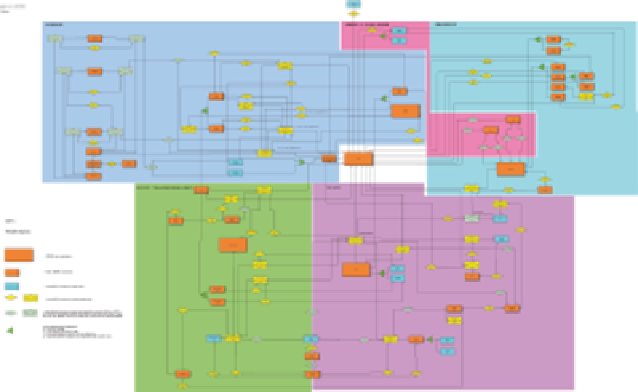Information Technology Reference
In-Depth Information
In order to overcome these shortcomings, it is proposed to convert the ontology as well
as the selected modelling grammar to meta models using the same language (e.g. ER
Models or UML Class Diagrams). This facilitates a pattern-matching approach towards
the ontological analyses of completeness and clarity of a grammar. As a first step we
converted, for example, the Bunge-Wand-Weber ontology into an ER-based meta model.
This meta model includes 50 entity types and 92 relationship types. It has clusters such
as system, property or class/kind. Such a meta model explains, in a language familiar to
the information systems (IS) community, the core constructs of the ontology. It also
highlights the underlying focus of the ontology. In the case of the BWW model, for ex-
ample, it is obvious from a visual inspection of the meta model that the ontology is
centred around the existence of a
thing
, which is the central entity type in the meta
model.
The obtained meta model can now be used for a variety of ontological analyses. Moreover,
it allows a critical review of the BWW model by a wider community. The approach,
however, is not without its limitations. Commonly used modelling techniques such as
ER or UML are often widely accepted but they have not been designed for the purposes
of meta modelling. Thus, they occasionally lack the required expressiveness. Figure 13.1
provides an impression of the size and complexity of the meta model for the BWW on-
tology.
Figure 13.1. The BWW meta model.
While an ER-based meta model helps to overcome issues related to the understandability
of an ontology, a corresponding meta model of the analysed grammar is required to deal
with the lack of comparability issue. Many popular modelling techniques (e.g. ARIS or
UML, and also interoperability standards such as ebXML) are already specified in meta
models using ER-notations or UML Class Diagrams. If the meta models for the ontology
and the modelling technique are specified in the same language, the ontological analysis
turns into a comparison of two conceptual models. As part of the analysis, it will be re-
quired to identify corresponding entity types and relationship types in both models. It
also becomes immediately obvious if the paradigm of the analysed grammar differs from
the ontology. In the case of ARIS or many Web Services standards, for example, the

Search WWH ::

Custom Search